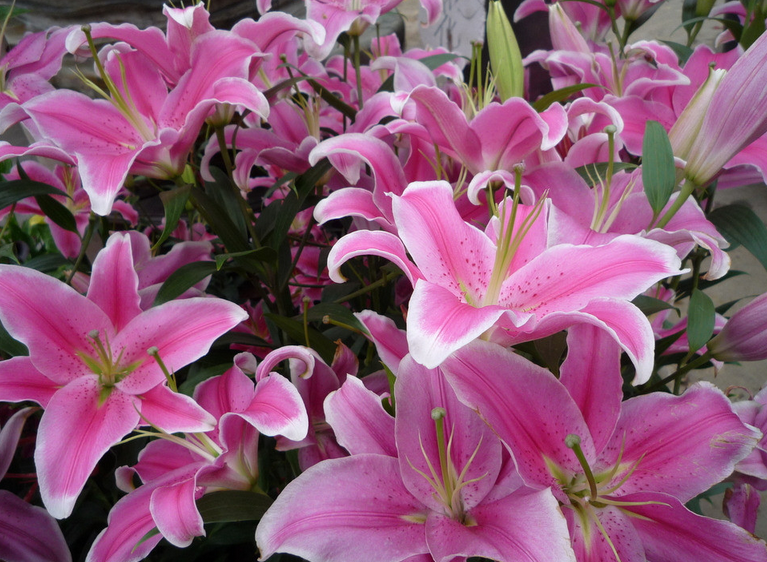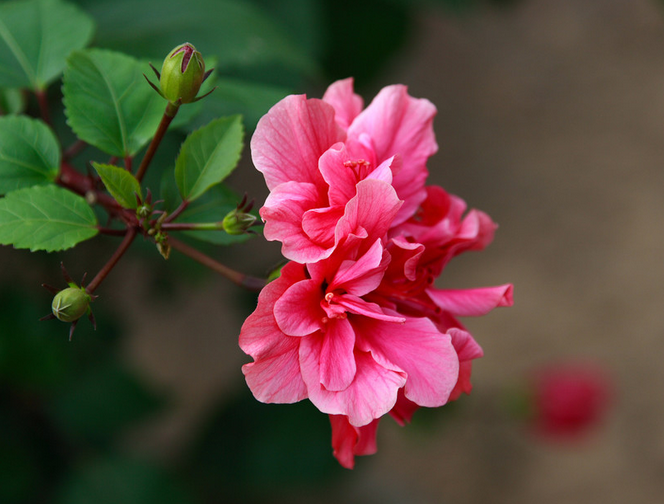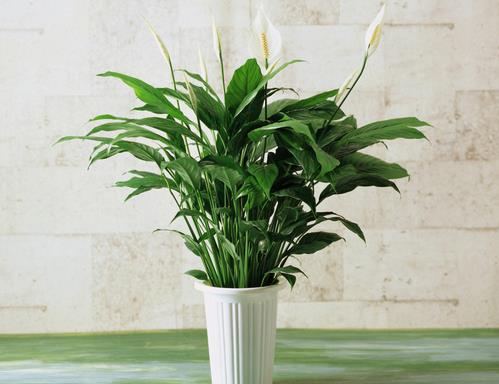How to cultivate lilies indoor culture methods
The lilies are pure and elegant and are known as "Yunchang fairies", so many people want to breed them indoors. The editor reminds you that when you breed lilies, you must first master some relevant knowledge. Here, let's learn more about the methods of lily culture with a decorated network editor.

How to cultivate lilies? indoor culture methods of lilies
How to grow lilies
1. Get ready to plant the ball. Some balls have not yet taken root, and it depends on the scale opening upward that is the bud.
2. Prepare the soil. Lily likes rich, sandy soil with good water retention and drainage, and you can make it yourself. Peat: River sand: perlite = 2:2:1. You can also use cactus soil, but you can't use clay anyway. It can also be nutritious soil with good drainage and is suitable for planting bulbous plants.
3. The basin. Lily is a bulb flower with two layers of roots, so a deeper pot is required. Generally use a 20 cm diameter basin, you can grow 2-3 heads. The 3 heads are more compact and will look better when they bloom.
4. Planting. Just buy lily bulbs had better be disinfected before planting, generally soak in imported carbendazim 1000 times solution for 20 minutes, rinse with clean water, and then plant after drying. First put 10-15 cm of soil at the bottom of the basin and put the ball. If there are three heads in a pot, the head of the ball is placed toward the edge of the flowerpot, that is, it is tilted like the edge of the pot, so that the plants can be evenly distributed after germination. Cover the top of the ball with soil of about 5 cm, pour water thoroughly and leave it in a cool place for 1-2 days.
5. Moisture. Usually keep moist, is to grab a handful of soil, squeeze hard, there is water seeping out of the fingers but not dripping. Do not overwater, too much water is easy to rot roots, watering thoroughly, not only half of the water. It takes a day or two for tap water to be used. In addition, it is necessary to use imported carbendazim 1000 times solution twice a month, the air humidity should reach 60-80%, and the humidity should be stable. if the humidity difference is too great, it is easy to get leaf burn, especially during the period from bud to flowering. At home, there is no need to bother, just spray water twice in the morning and evening.
6. Fertilization. The amount of fertilizer applied to lilies is not large, and it is generally necessary to apply fertilizer once a month. Long-acting Austrian green manure, available nitrogen fertilizer and available phosphorus and potassium fertilizer were used together. You can ask the seller how to use it.
7. Light. Lily requires more shading in the early stage, generally 60% shading, when the sun is not strong, can not shade, so that the plant is stronger, more dwarfed, and the flowers are large and gorgeous.
8. Florescence. It usually takes 3 months to produce beautiful lilies.
9. After blooming, the lily can be cut off, because the flowering has consumed a lot of nutrients of the ball. If you want to keep the ball, you must continue to fertilize and replenish the ball. After a month, you can dig the ball out, cut the whisker root, put it in the refrigerator for a period of time, break the dormancy, and plant it later, but the quality of the flower will decline, which is definitely not as good as the first crop.
Matters needing attention in lily culture
Pot planting should be carried out from September to October. The cultivated soil should be mixed with rotten leaf soil, sandy soil and garden soil at the ratio of 1:1:1, and the basin bottom should be fully mature compost and a small amount of bone powder as base fertilizer.
The planting depth is generally about 2-3 times the diameter of the bulb. Lily does not have a high demand for fertilizer, which is usually applied at the beginning of spring growth and the early stage of flowering. Some foreign growers believe that lilies need more nitrogen and potassium fertilizer, and should be applied every 10 to 15 days during the growing period, while the supply of phosphate fertilizer should be limited, because too much phosphate fertilizer will cause withered and yellow leaves.
Phosphate fertilizer can be increased by 1 to 2 days at flowering stage. In order to enrich the bulb, the residual flowers should be cut off in time after flowering to reduce nutrient consumption. Watering only needs to keep the pot soil moist, but it should be watered properly during the peak growing season and dry weather, and often sprinkle water around the flowerpot to improve air humidity.
Pot soil should not be too wet, otherwise bulbs are easy to rot, potted lilies change pots once a year and replace them with new culture soil and base fertilizer. In addition, the flowerpot should be turned once a week during the growing period. Otherwise, the plant is easy to be too long, affecting the appearance.
How to raise lilies, how to cultivate lilies, how to cultivate lilies indoors
Introduction: lilies are known as "Yunchang fairies". Its appearance is elegant and pure, and the bulbs of lilies are made up of scales, with the meaning of "a hundred years of harmony" and "Pepsi agreement". Since ancient times, the Chinese have regarded it as an indispensable auspicious flower for weddings. So how to raise plain and elegant lilies? Let's let the editor introduce to you.
Indoor culture methods of lilies:
Suitable temperature
The suitable temperature for the growth of lily is 1525 ℃, the temperature is lower than 10 ℃, the growth is slow, and when the temperature is more than 30 ℃, the growth is poor. In the process of growth, the temperature of 21: 23 ℃ in daytime and 15: 17 ℃ at night was the best. The bulbs that promote cultivation must be stored at 7: 10 ℃ for 4 to 6 weeks. This growth habit of lilies determines its maintenance mode. Soil and light
Attention should be paid to soil preparation and fertilization, lilies are more adaptable, and the climate is mild and sunny. The soil should be sandy loam with deep soil layer and good drainage, followed by clay, and waterlogged land should not be planted.
Water supply
You have to drain it when you do it. Lilies need wet water to grow, which is beneficial to the growth of stems and leaves. If the soil is too wet, stagnant water or poor drainage, the lily bulbs will rot and die. Watering of potted lilies should be gradually increased with the growth of plants, sufficient water supply should be provided during flowering, water should be reduced after flowering, and watering should be stopped after aboveground parts withered.
Pest control
Lily diseases and insect pests are mainly caused by black spot, gray mold and rust, which can be controlled by spraying 500 times of 25% carbendazim wettable powder. Insect pests are harmful to grubs and aphids and can be sprayed with 1000 times of dichlorvos EC. This is the end of the introduction on how to cultivate lilies. I hope it will be helpful to you.
How to raise lilies? how to raise lilies? introduction to indoor culture methods of lilies
Lilium is a perennial herb of Liliaceae. It has at least 120 varieties, 55 of which are produced in China. Lily is a very beautiful flower, its flowers are large, mostly white, funnel-shaped. The lily flowers are elegant, the leaves are green and beautiful, and the stems are graceful, which is of great appreciation value. Next, let's take a look at the lilies and the indoor cultivation of lilies. The temperature of lily indoor culture method is 15 ~ 25 ℃, the temperature is lower than 10 ℃, the growth is slow, the temperature is more than 30 ℃, the growth is poor. In the process of growth, the temperature of 21: 23 ℃ in daytime and 15: 17 ℃ at night was the best. The bulbs that promote cultivation must be stored at 7: 10 ℃ for 4 to 6 weeks. This growth habit of lilies determines its maintenance mode. Lily indoor culture methods of soil and light soil preparation and fertilization should pay attention to, lily adaptability is strong, the climate is mild and sunny is better. The soil should be sandy loam with deep soil layer and good drainage, followed by clay, and waterlogged land should not be planted. The water supply of indoor culture of lilies should be drained when it is time. Lilies need wet water to grow, which is beneficial to the growth of stems and leaves. If the soil is too wet, stagnant water or poor drainage, the lily bulbs will rot and die. Watering of potted lilies should be gradually increased with the growth of plants, sufficient water supply should be provided during flowering, water should be reduced after flowering, and watering should be stopped after aboveground parts withered. The diseases and insect pests of lily indoor culture methods mainly include black spot, gray mold and rust, which can be controlled by spraying 500 times of carbendazim wettable powder. Insect pests are harmful to grubs and aphids and can be sprayed with 1000 times of dichlorvos EC. This is the end of the introduction on how to cultivate lilies. I hope it will be helpful to you.
Picture appreciation of lilies [red lilies]: red lilies are lilies, perennial herbs and species of lilies. Its Corolla is long tube-shaped and hypertrophy, the color is reddish and deeply split, and the petals are thick and wrinkled with purplish red veins. Hua Yu: always love you, as passionate as fire. [yellow lily]: yellow lily symbolizes purity, chastity and innocence. It is also a symbol of maternal love. In ancient Roman weddings, brides would use yellow lilies with wheat ears on their heads as their headdress, implying a good harvest of grain and a hundred years of harmony. [pink lily]: pink lily symbolizes purity and elegance, and pink lily is one of them. Lilies are colorful, and most people associate white lilies with innocence and sweetness.
- Prev

Analysis of Culture methods of Mulberry Leaf Peony
Mulberry leaf peony is a famous flower in China, with large flowers and many colors. Although it is ridiculed in the morning, it goes on and on, with a long flowering period and the most blooming summer and autumn flowers. Many people want to raise mulberry leaf peonies on their own. Next, let's learn more about the cultivation methods of mulberry leaf peony with the editor of the decoration network.
- Next

What is the breeding method of white palm? What if the leaves of white palm droop?
White palm is loved by new consumers because of its simple maintenance and elegant style. In addition to it is called white palm, it can also be called white taro, it is a very good ornamental plant. Do you know the culture method of white palm? What are the matters needing attention in the breeding of white palm?
Related
- Fuxing push coffee new agricultural production and marketing class: lack of small-scale processing plants
- Jujube rice field leisure farm deep ploughing Yilan for five years to create a space for organic food and play
- Nongyu Farm-A trial of organic papaya for brave women with advanced technology
- Four points for attention in the prevention and control of diseases and insect pests of edible fungi
- How to add nutrient solution to Edible Fungi
- Is there any good way to control edible fungus mites?
- Open Inoculation Technology of Edible Fungi
- Is there any clever way to use fertilizer for edible fungus in winter?
- What agents are used to kill the pathogens of edible fungi in the mushroom shed?
- Rapid drying of Edible Fungi

